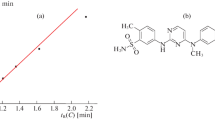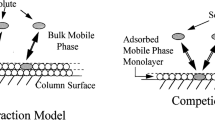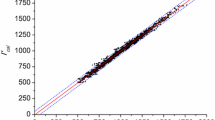Summary
The retention data of isomeric xylenes, ethyltoluenes and diethylbenzenes, and of mesitylene, benzene, toluene and ethylbenzene were obtained on a reversedphase column using methanol-water and ethanol-water mobile phases at four different temperatures. This database was used to relate the dependence of solute retention and resolution on the polarity of the mobile phase, solute dipole moment, and column temperature. The additivity of the free energy of the transfer of solute molecules or solute segments from the stationary phase to the mobile phase, was examined for the isomeric compounds. For this, the logarithm of the net retention volume was substituted for the free energy. Deviations from the additivity of free energies indicate that the separation of isomeric substituted alkylbenzenes is governed by their differential interactions with both the polar mobile phase and nonpolar stationary phase. Among the disubstituted alkylbenzenes,ortho-isomers favor the mobile phase more andpara-isomers tend to prefer the stationary phase more. Themeta-isomers are found to follow the additivity rule closely. These trends are amplified as the polarity of the mobile phase is increased indicating that these isomers are resolved better in water-rich mobile phases. These findings are substantiated by analogous results from gas-liquid chromatographic retention data, estimation of dipole moment effects, and examination of the entropic and enthalpic contributions to the net retention volume.
Similar content being viewed by others
References
K. Jinno, K. Kawasaki, Chromatographia17, 337 (1983).
R.M. Smith, J. Chromatogr.209, 1 (1981).
Y. Kawaguchi, M. Tanaka, M. Nakae, K. Funazo, T. Shono, Anal. Chem.55, 1852 (1983).
C.R. Clark, M.J.M. Wells, R.T. Sansom, J.R. Humerick, W.B. Brown, B.J. Commander, J. Chromatogr. Sci.22, 75 (1984).
B.N. Barman, Analyst111, 479 (1986).
J.H. Knox, J. Kriz, E. Adamcova, J. Chromatogr.447, 13 (1988).
A.A. Aratskova, Ya. I. Yashkin, Zh. Anal. Khim.46, 320 (1991).
M. Tanaka, Y. Kawaguchi, T. Shono, J. Chromatogr.267, 285 (1983).
A.N. Ageev, A.V. Kiselev, Ya. I. Yashin, Dokl. Phys. Chem.249, 377 (1979).
A.V. Kiselev, A.A. Aratskova, T.N. Gvozdovitch, Ya. I. Yashin, J. Chromatogr.195, 205 (1980).
I. Schmeltz, C.T. Dyer, E. Ratchik, J. Matasker, J. Chromatogr.245, 309 (1982).
A. Ono, J. Chromatogr.180, 170 (1979).
K.P. Naikwadi, D.G. Panse, B.V. Bapat, B.B. Ghatge, J. Chromatogr.206, 361 (1981).
P.P. Pawar, K.P. Naikwadi, S.M. Likhite, B.V. Bapat, B.B. Ghatge, J. Chromatogr.245, 57 (1982).
J.K. Haken, I.O.O. Korhonen, J. Chromatogr.265, 323 (1983).
A. Ono, Analyst108, 1265 (1983).
T. Czajkowska, J. Chromatogr.241, 9 (1982).
B.L. Karger, L.R. Snyder, C. Horvath, “An Introduction to Separation Science”, John Wiley & Sons, New York (1973), pp. 166–167.
H. Colin, J.C. Diez-Masa, G. Guiochon, T. Czajkowska, I. Miedziak, J. Chromatogr.167, 41 (1978).
N.L. Ha, J. Ungvaral, E. sz. Kováts, Anal. Chem.54, 2410 (1982).
A.M. Krstulovic, H. Colin, G. Guiochon, Anal. Chem.54, 2438 (1982).
G.C. Benson, O. Kiyohara, J. Solution Chem.9, 791 (1980).
B.N. Barman, Ph. D. Dissertation, Georgetown University (1985).
J.H. Knox, E. sz. Kováts, discussion contribution, Faraday Symp. Chem. Soc., No. 15, p. 177 (1980).
D.E. Martire, R.E. Boehm, J. Phys. Chem.87, 1045 (1983).
Author information
Authors and Affiliations
Additional information
Dedicated to Professor Leslie S. Ettre on the occasion of his 70th birthday.
Rights and permissions
About this article
Cite this article
Barman, B.N., Martire, D.E. Factors influencing retention and resolution of substituted alkylbenzenes in reversed-phase liquid chromatography. Chromatographia 34, 347–356 (1992). https://doi.org/10.1007/BF02268367
Received:
Accepted:
Issue Date:
DOI: https://doi.org/10.1007/BF02268367




